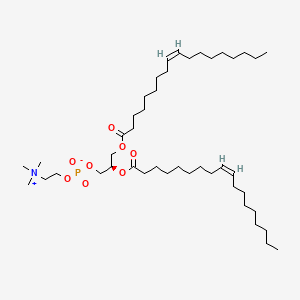1,2-Dioleoyl-sn-Glycero-3-Phosphocholine
1,2-Dioleoyl-sn-Glycero-3-Phosphocholine is a lipid of Glycerophospholipids (GP) class. 1,2-dioleoyl-sn-glycero-3-phosphocholine is associated with abnormalities such as Exanthema, Renal tubular disorder, Nodule, Gigantism and Mycoses. The involved functions are known as Lysis, Encapsulation, Process, Uptake and Flow or discharge. 1,2-dioleoyl-sn-glycero-3-phosphocholine often locates in Cytoplasmic matrix, Endosomes, soluble, Endoplasmic Reticulum and Membrane. The associated genes with 1,2-Dioleoyl-sn-Glycero-3-Phosphocholine are P4HTM gene, synthetic peptide, BCAR1 gene, PCNA gene and CNTNAP1 gene. The related lipids are Liposomes, 1,2-oleoylphosphatidylcholine, 1,2-distearoylphosphatidylethanolamine, Butanols and Cardiolipins. The related experimental models are Mouse Model and Xenograft Model.
References related to functions published in J. Biol. Chem.
| PMID | Journal | Published Date | Author | Title |
|---|---|---|---|---|
| 8662651 | J. Biol. Chem. | 1996 | Dolis D et al. | Transmembrane movement of phosphatidylcholine in mitochondrial outer membrane vesicles. |
| 7629083 | J. Biol. Chem. | 1995 | Vidal M and Hoekstra D | In vitro fusion of reticulocyte endocytic vesicles with liposomes. |
| 9442064 | J. Biol. Chem. | 1998 | Tojo H et al. | Purification and characterization of a catalytic domain of rat intestinal phospholipase B/lipase associated with brush border membranes. |
| 10075652 | J. Biol. Chem. | 1999 | Reddy LG et al. | Co-reconstitution of phospholamban mutants with the Ca-ATPase reveals dependence of inhibitory function on phospholamban structure. |
| 11564736 | J. Biol. Chem. | 2001 | Simberg D et al. | Phase behavior, DNA ordering, and size instability of cationic lipoplexes. Relevance to optimal transfection activity. |
| 20826816 | J. Biol. Chem. | 2010 | Zhou Y et al. | The anti-inflammatory drug indomethacin alters nanoclustering in synthetic and cell plasma membranes. |
| 17616528 | J. Biol. Chem. | 2007 | Hughes E et al. | Solid-state NMR and functional measurements indicate that the conserved tyrosine residues of sarcolipin are involved directly in the inhibition of SERCA1. |
| 15668234 | J. Biol. Chem. | 2005 | Salamon Z et al. | Plasmon-waveguide resonance studies of lateral segregation of lipids and proteins into microdomains (rafts) in solid-supported bilayers. |
| 15708860 | J. Biol. Chem. | 2005 | Cohen E et al. | Purification of Na+,K+-ATPase expressed in Pichia pastoris reveals an essential role of phospholipid-protein interactions. |
| 18505730 | J. Biol. Chem. | 2008 | Ugolev Y et al. | Dissociation of Rac1(GDP).RhoGDI complexes by the cooperative action of anionic liposomes containing phosphatidylinositol 3,4,5-trisphosphate, Rac guanine nucleotide exchange factor, and GTP. |
| 18819911 | J. Biol. Chem. | 2008 | van den Bogaart G et al. | On the mechanism of pore formation by melittin. |
| 22763701 | J. Biol. Chem. | 2012 | Rostovtseva TK et al. | Membrane lipid composition regulates tubulin interaction with mitochondrial voltage-dependent anion channel. |
| 27440045 | J. Biol. Chem. | 2016 | Martfeld AN et al. | Ionization Properties of Histidine Residues in the Lipid Bilayer Membrane Environment. |
| 25575593 | J. Biol. Chem. | 2015 | Grosjean K et al. | Differential effect of plant lipids on membrane organization: specificities of phytosphingolipids and phytosterols. |
| 25164812 | J. Biol. Chem. | 2014 | Kacprzyk-Stokowiec A et al. | Crucial role of perfringolysin O D1 domain in orchestrating structural transitions leading to membrane-perforating pores: a hydrogen-deuterium exchange study. |
